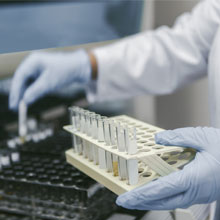Microbiologists react: Over a million people died in 2019 from antibiotic-resistant infections
21 January 2022

An estimated 1.2 million people – and potentially millions more – died in 2019 as a direct result of antibiotic-resistant bacterial infections, according to the most comprehensive study to date of the global impact of antimicrobial resistance (AMR).
The analysis of 204 countries and territories, published in The Lancet, confirms AMR as a leading cause of death worldwide, with worst impacts on low- and middle-income countries. It shows that many hundreds of thousands of deaths now occur due to common, previously treatable infections – such as lower respiratory and bloodstream infections – because the bacteria that cause them have become resistant to treatment.
The report highlights that spending should urgently be directed to preventing infections in the first place, making sure existing antibiotics are used appropriately and judiciously, and to bringing new antibiotics to market. It also calls for policymakers at all levels to take seriously the importance of addressing AMR and the challenge of poor access to affordable, effective antibiotics.
Microbiology Society members with expertise in AMR reacted to the new study:
Dr Tina Joshi, Lecturer in Molecular Microbiology at the University of Plymouth (UK) and co-Chair of the Microbiology Society’s Impact and Influence Committee, said:
“Antimicrobial resistance is now a leading cause of death worldwide. We urgently need feasible solutions and investment to address this silent pandemic globally. It is time for our world leaders to recognise the current and future negative impact of not addressing AMR.”
Dr Adam Roberts, Reader, Antimicrobial Chemotherapy and Resistance, at the Liverpool School of Tropical Medicine (UK), said:
“Ever since the publication of the AMR Review by Lord O’Neill and colleagues there has been a debate around the figures for current and predicted deaths due to AMR. Arguments ranged from gross underestimations to the inclusions of caveats that the figures presented were unlikely as it meant every microbe was resistant to every drug used to treat it. Whilst argument and discussion around these numbers was necessary and useful at the time, I think it was also distracting and dilutive in terms of focused effort on solutions by governments and international bodies. What this new study shows comprehensively is that actually these figures were conservative and the problem of AMR, in relation to deaths from bacterial disease, is, and has been for some time, enormous. This should now allow multiple agencies to prioritise efforts and funding on the multiple solutions necessary to manage AMR.”
Bhavik Barochia, Postgraduate Researcher of Clinical Microbiology within the National Biofilm Innovation Centre (UK), said:
“It is incredibly sad to see that 1.2 million people lost their lives in 2019 due to what were once completely preventable and treatable infections. We are awakening to the harsh but serious reality that we are on the precipice of a second worldwide pandemic. Not from a new assailant but from an old enemy, once kept constrained through an affective antimicrobial arsenal of drugs. We need urgent action now.”
Professor Gilles P. van Wezel, Director of the Institute of Biology at Leiden University (The Netherlands), said:
“In the days of COVID-19, it is easy to forget about bacterial infections and the risk of antimicrobial resistance. Predictions are that in 2050 we may have as many as 10 million deaths due to AMR, among others for an urgent lack of antibiotics, but it all seems far away. Now this paper in the Lancet predicts that already in 2019, millions of people have likely died from infections that are associated with antibiotic resistance. It shows why AMR is referred to as the silent pandemic.”
Professor Arindam Mitra, Professor of Microbiology at Adamas University (India), said:
“This study is timely and relevant. Antimicrobial resistance is increasing at an alarming rate around the world and these findings should be an eye opener to common public. Antibiotic stewardship should be one of the public health priorities around the world and children should be made aware of AMR so that the next generation takes better decision when it comes to antibiotic.”
Professor Jose Bengoechea, Director of the Wellcome Wolfson Institute for Experimental Medicine, Queen’s University Belfast (UK), said:
“The recent paper published in the Lancet reveals the global scale of the global AMR pandemic globally. In 2019, antibiotic resistant infections killed more than HIV, malaria or cancer. Unfortunately what was perceived as a future problem, it is happening already. Worryingly, of the major bacterial microbes covered in the study, there is only a vaccine for one. The others are in fact included in a list of the World health Organization for which new drugs are urgently needed. This data should lead to take urgent action because AMR is no longer a ‘silent’ pandemic.”
Raphael Galleh, Doctoral Researcher at the University of Sheffield (UK) and member of the Microbiology Society’s Early Career Microbiologists Forum Executive Committee, said:
“The adverse effects of antimicrobial resistance cannot be overemphasised. Also, with the high rates of drug abuses all over the world especially in African countries, the menace may continue to thrive if nothing is being done to curtail it. This article is therefore timely and I will advocate for the inclusion of AMR in the curriculum of both primary and secondary schools which will help in preventing emerging and re-emerging diseases.”
Explore more of the Microbiology Society’s work on AMR here, including further reading and resources, recommendations for policy-makers and funders, interviews with members working in the field of AMR research and our journal collections.
Image: iStock/pattonmania.
